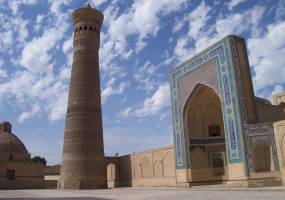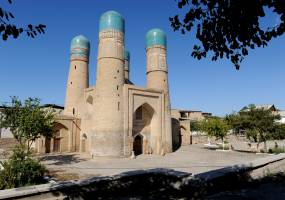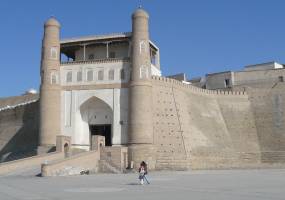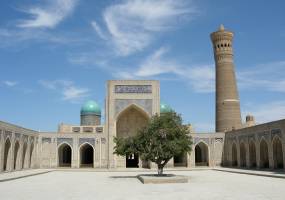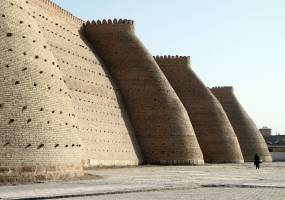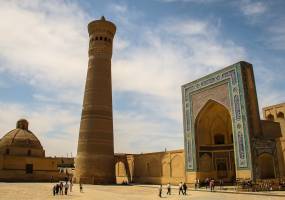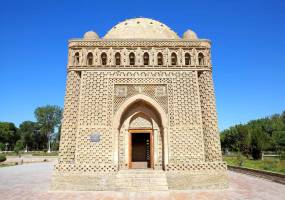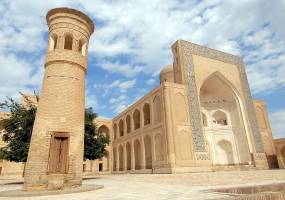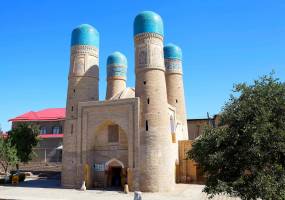Bukhara is situated in the north-west of Uzbekistan, nearly 200 km from Samarkand. Bukhara is one of the most ancient cities in Central Asia. “Star of Islamic world” and “noble city of Central Asia” - it had deservedly got these titles; there were 360 mosques and 80 madrassas in Middle Ages. Old legend says that the light of God's divine grace descends from the sky on all Muslim cities, and only in Bukhara it rises up. Founded 2500 years ago by Persian prince Siavash as royal citadel, the city started to develop quickly thanks to its strategic location on the crossover of trade routes, leading to Merv, Urgench, Kabul, and Samarkand. The city got its modern look in the time of Shaibanid and Ashtarkhanid Dynasties (16th-17th), when most of wonderful mosques and madrassas, caravanserais and bathhouses, fortified walls and gates, and also architectural ensembles and burial vaults were built. This amazing city was not beyond the scope of its fortified wall, built in 16th century, and contained many religious buildings and bazaars, where everything could be bought. To walk on the Old Bukhara, founded in the first centuries BC, you happen to visit ancient civilization monuments. The walls of old citadel, more than 140 architectural monuments of Muslim era, and amazing districts and narrow streets of old town remained till our days. The pearl of the city is small Samanid mausoleum; it has celebrated its thousandth anniversary recently (Bukhara had been the capital of this dynasty). At a distance, this very proportional burial vault looks like carved goldish casket, crowned with low cupola. Close by, many tourists “have their eyes on the forehead” from the amusement because the whole mausoleum was built from simple baked brick, but the art of brickwork and fanciful brick carving creates such game of the light and shadow that the whole look of mausoleum is filled with air and absolute grace. Another architectural symbol of Bukhara was built in this way – architectural complex Po-i Kalyan (“Grand Foundation”), which consists of great Kalyan minaret (1127, it is considered to be the highest in Asia), Kalyan mosque, and two madrassas – Mir-i Arab (1536) and Emir-Alimkhan (20th). Fantastic panorama of ancient Bukhara is opened from the round gallery at the minaret’s lantern. Architectural monuments with universal importance are also Chashma-Agrob mausoleum (Chashma-Ayub, 1380); Buyan-Khuli-Khan mausoleum with fine terra-cotta walls’ decoration (1358); Saifiddin Bokharzi mausoleum (13th-14th); summer residence of Bukhara emirs – city fortress the Ark (15th-19th), religious Gaukushon ensemble near Khoja-Kalyan mosque, Khoja-Gaukushon minaret and madrassah (1570); Tack-i-Telpack-Furushon arcades (16th); unique Magock-i Attori mosque (1546-1547); palatial Jami mosque (19th); Balyand (14th) and Khoja-Zainuddin (1555) mosques; Bola-Hauz mosque and madrassah (18th); Ulugh Bek madrassah (11th-16th, the only building of his governing time); Abdulaziz-Khan madrassah on the opposite side of Ulugh Bek madrassah (1652); Modar-i Khan (1566-1567) and Abdulla-Khan madrassas (1558-1590, together they are Kosh-madrassah – “double madrassah”); Chor-Minor madrassah (1807), and country palace of the last emir – Mokh-i Khossa (19th-20th, 4 km to the north from Bukhara). Lab-i Hauz is the centre of another great monument of Bukhara. “Hauz” means pond, and it is unnecessary to mention the importance which ponds had played in the life of this city, situated on the edge of sultry deserts. Lab-i Hauz is a pool with rectangular shape and cut angles, surrounded by three monumental madrassas of 16th-17th centuries; it used to be the centre of social city life. The Kukeldash Madrassah(1568–1569) and Nadir Divan-Beghi khanaka (1622) make up one ensemble, where Lab-i Hauz is the central element. Amazing heap of cupolas of Tock-i Zargaron market and many other fine architectural monuments has remained till our days. And, of course, nobody can pass noisy Bukhara bazaars. There are some historical monuments concentrated around Bukhara – Varakhsha settlement with palace (5th-9th) and Ibrahim Okhunda madrassah (1884); country Namozgokh mosque to the south of the city (12th-16th); shelter for travelling dervish-monks – Faizabad khanaka (1598-1599); burial vault of sheikhs of “nakshbandiya” order – Chor-Bakr necropolis in the Sumitan settlement (16th, burial place of Jubairi Shaeikh’s family); Bakhauddin Nakshbandi mausoleum – patron saint of Bukhara and spiritual leader of Timur, founder of Sufi “Nakshbandiy” order (1560-1563); the tomb of Bakhauddin Nakshbandi teacher – Kharzrat Said Amir Culol, in the Kasri-Arifon settlement, and Rabat-i Malik caravanserai ruins in Kermin.
For the city tour 195$
The price includes:
- Transportation costs
- Entrance tickets
- We will meet you at the hotel and take you back after the tour (or to the airport/railway station)
- The duration of the tour is approximately 4 astronomical hours, depending on the interest of the tourists
- We will be able to adjust the route according to your wishes
- We take into consideration all the wishes of customers
